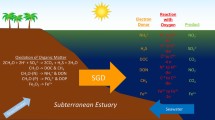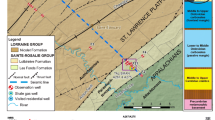Abstract
Water wells were sampled near North Madison, Ohio, following a gas well blow out that injected large amounts of CH4 into near-surface groundwater Chemical analyses showed elevated levels of Fe+2, Mn+2, Ca+2, sulfide, alkalinity, and pH, and low levels of dissolved oxygen, SO4 −2, and NO3 − in CH4-affected wells compared to unaffected wells. Sulfate reduction is quantitatively the most important vehicle for CH4 oxidation Equilibrium thermodynamic computer models were used to simulate groundwaters from the North Madison area Model results showed that CH4 is oxidized to HCO3 −, SO4 −2 is reduced, iron and manganese oxides are reduced and dissolved, and pH increases These simulations are in excellent agreement with trends observed in the field data A laboratory experiment was designed to simulate CH4 − perturbed groundwater in the methane-perturbed system, sulfide increased significantly, providing direct evidence for methane oxidation by sulfate reduction
Although suitable anaerobic methane-oxidizing bacteria have not been isolated from groundwater aquifers, the combination of field data, laboratory experiment, and computer simulation form a convincing argument that CH4 perturbation of aquifers can and does affect groundwater chemistry
Similar content being viewed by others
References Cited
Back, W, and I. Barnes, 1965, Relation of electrochemical potentials and iron content to groundwater flow patterns:U.S. Geol. Surv, Prof. Pap. 498-C
Baedecker, M. J., and W. Back, 1979, Hydrogeological processes and chemical reactions at a landfill.Ground Water, v. 17, p. 429–437.
Ball, J. W., E. A. Jenne, and D. K. Nordstrom, 1979, WATEQ2—a computerized chemical model for trace and major element speciation and mineral equilibria of natural waters,in E. A. Jenne, ed., Chemical Modeling in Aqueous Systems: Amer Chem. Soc Symp. Ser no. 93, p 815–835
Ball, J. W., D. K. Nordstrom, and E. A. Jenne, 1980, Additional and revised thermochemical data and computer code for WATEQ2—a computerized chemical model for trace and major element speciation and mineral equilibria of natural waters:U.S. Geol. Surv Water-Resources Investigation, p. 78–116.
Barker, J. F., and P. Fritz, 1981a, The occurrence and origin of methane in some groundwater flow systems.Can. J. Earth Sci, v 18, p. 1802–1816.
Barker, J. F., and P. Fritz, 1981b, Carbon isotope fractionation during microbial methane oxidation.Nature, v. 293, p. 289–291.
Barnes, R. O., and E. D. Goldberg, 1976. Methane production and consumption in anoxic marine sediments.Geology, v. 4, p. 297–300.
Beebe, R. R., and H. W. Rauch, 1979, Lineaments and ground-water chemistry as exploration tools for Devonian shale gas in the Midway-Extra field of West Virginia,in H. Barlow, ed., Proceedings of the Third Eastern Gas Shales Symposium: 1979, U.S.D.O.E. Morgantown Energy Technology Center, p. 277–289.
Cappenberg, T. E., 1975, A study of mixed continuous cultures by sulfate-reducing and methane-producing bacteria.Microbial Ecol., v. 2, p. 60–72.
Cherry, J. A., A. J. Shaikh, D. E. Tallman, and R. V. Nicholson, 1979, Arsenic species as an indicator of redox conditions in groundwater.J Hydrol, v. 43, p. 373–392.
Devol, A. H., 1983, Methane oxidation rates in the anaerobic sediments of Saanich Inlet.Limnol Oceanogr, v. 28, p. 738–742.
Devol, A. H., and S. I. Ahmed, 1981, Are high rates of sulfate reduction associated with anaerobic methane oxidation?:Nature, v. 291, p. 407–408.
Dohnalek, D. A., and J. A. Fitzpatrick, 1983, The chemistry of reduced sulfur species and their removal from ground-water supplies.Am Water Works Assoc J., v. 75, p. 298–308.
Drozd, R. J., 1981, Monitoring hydrocarbon migration by the application of carbon and oxygen isotopic methods to carbonate species dissolved in groundwater: Abs. Am. Chem. Soc. Conf., Atlanta, GA.
Dyck, W., A. K. Chatterjee, D. E. Gemmell, and K. Murricane, 1976, Well water trace element reconnaissance, eastern maritime Canada,J Geochem Exploration, v 6, p 139–162.
EPA, 1979, Methods for Chemical Analysis of Water and Wastes: Environmental Monitoring and Support Laboratory, Office of Research and Development. EPA-600/4-79-020.
Ferry, J. G., and H. D. Peck, 1977, Relationship between sulfate reduction and methane production in salt marsh sediments: Abs. Ann. Meeting Am. Soc. Microbiology, N49, p. 236.
Gunsalus, R. P., J. G. Zeikus, and R. S. Wolfe, 1972, Microbial modification of ground waters: Univ. of Ill. Water Resources Center, Research Report no. 57.
Hallberg, R. O., and R. Martinell, 1976, Vyredox—in situ purification of ground water:Ground Water, v 14, p. 88–93.
Inglis, J. M., 1982, Nitrate contamination in a shallow, unconfined aquifer in Perry, Ohio: M.S thesis, Case Western Reserve University.
Jannasch, H. W., 1975, Methane oxidation in Lake Kivu [central Africa],Limnol Oceanogr., v. 20, p. 860–864
Jones, D. S., and H. W. Rauch, 1978, Lineaments and ground-water quality as exploration tools for ground water and gas in the Cottageville area of western West Virginia: Proceedings of the Second Eastern Gas Shales Symposium, 1978, U.S.D.O.E. Morgantown Energy Technology Center, p. 196–205.
Kelly, W. R., 1983, The effects of methane perturbation on the chemistry and quality of ground water systems: M.S. thesis, Case Western Reserve University.
Kramer, L., 1983, Madison gas well blowout, August, 1982: Lake County, Ohio, General Health District Report.
Kuznetsov, S. I., 1970, The microflora of lakes and its geochemical activity: Univ. of Texas Press
Langmuir, D., 1978, Uranium solution-mineral equilibria at low temperatures with applications to sedimentary ore deposits:Geochim Cosmochim Acta, v. 42, p. 547–570.
Martens, C. S., and R. A. Berner, 1977, Interstitial water chemistry of anoxic Long Island Sound sediments 1 Dissolved gases:Limnol Oceanogr, v 22, p 10–25.
Olson, G. J., W. S. Dockins, G. A. McFeters, and W. P. Iverson, 1981, Sulfate-reducing and methanogenic bacteria from deep aquifers in Montana:Geomicrobiol J, v. 2, p. 327–341.
Oremland, R. S., and B. F. Taylor, 1978, Sulfate reduction and methano-genesis in marine sediments:Geochim Cosmochim Acta, v 42, p 209–214
Parkhurst, D L., D C Thorstenson, and L. N. Plummer, 1980, PHREEQE—A computer program for geochemical calculations:U S Geol Surv Water-Resources Investigation, p. 80–96.
Reeburg, W. S., 1976, Methane consumption in Cariaco Trench waters and sediments.Earth Planet Sci Lett., v 28, p. 337–344.
Reeburgh, W S, 1980, Anerobic methane oxidation: Rate depth distributions in Skan Bay sediments.Earth Planet Sci Lett. v. 47, p 345–352.
Reeburgh, W. S., and D T Heggie, 1977, Microbial methane consumption reactions and their effect on methane distributions in freshwater and marine environments:Limnol Oceanogr, v 22, p. 1–9.
Rand, M C., A. E. Greenberg, and M. J. Taras, eds., 1975, Standard Methods for the Examination of Water and Wastewater: Am Pub. Health Assoc.
Rudd, J. W. M., A. Furutani, R. J. Flett, and R. D. Hamilton, 1976, Factors controlling methane oxidation in shield lakes: The role of nitrogen fixation and oxygen consumption.Limnol. Oceanogr, v. 21, p. 357–364
Rudd, J. W. M., and R. D. Hamilton, 1979, Methane cycling in Lake 227 in perspective with some components of carbon and oxygen cycles.Arch. Hydrobiol Beth. Ergebn Limnol, v. 12, p. 115–122.
Rudd, J. W. M., R. D. Hamilton, and N. E. R. Campbell, 1974, Measurement of microbial oxidation of methane in lake water:Limnol Oceanogr, v. 19, p. 519–524.
Schmidt, J J, 1978, The groundwater resources of Lake County, Ohio:Ohio Dept Nat Res, Div of Water
Solorzano, L., 1969, Determination of ammonia in natural waters by the phenolhypochlorite method:Limnol Oceanogr, v. 14, p 799–801.
Stookey, L. L., 1970,Analytical Chemistry, v 42, p. 779–781.
Stumm, W., and J. J. Morgan, 1981,Aquatic Chemistry, New York, John Wiley and Sons.
Thorestenson, D C., D W Fisher, and M G Croft, 1979, The geochemistry of the Fox Hills-Basal Hell Creek Aquifer in southwestern North Dakota and northwestern South Dakota:Water Resources Res, v. 15, p 1479–1498.
White, G. W., 1980, Glacial geology of Lake County, Ohio: Dept. Nat. Res., Div. Geol. Surv. Dept of Invest no 117
Winfrey, I R, and J G Zeikus, 1977, Effects of sulfate on carbon and electron flow during microbial methanogenesis in freshwater sediments:Appl. Environ Microbiol, v 33, p. 275
Author information
Authors and Affiliations
Rights and permissions
About this article
Cite this article
Kelly, W.R., Matisoff, G. & Fisher, J.B. The effects of a gas well blow out on groundwater chemistry. Environ. Geol. Water Sci 7, 205–213 (1985). https://doi.org/10.1007/BF02509921
Issue Date:
DOI: https://doi.org/10.1007/BF02509921




